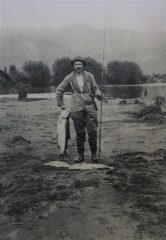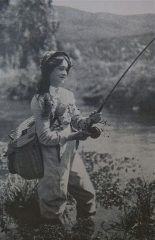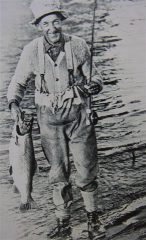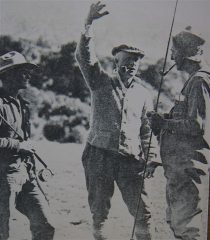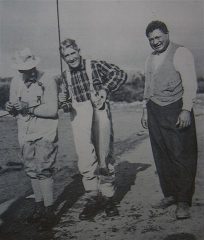Blog Archives for 2007
29 November
Storage containers cause of dead didymo cell spread
Jim Anderton’s Press Release
“Contamination of water sampling containers was almost certainly the source of the
dead didymo cells found in four central North Island rivers in late
October,†Biosecurity Minister Jim Anderton announced today.
The
finding is the result of investigations by both MAF Biosecurity New
Zealand and the National Institute of Water & Atmospheric Research
(NIWA) into the origin of the dead didymo cells reported from the
Tongariro, Whakapapa, Mangatepopo and Whanganui Rivers as part of
Genesis Energy’s monthly water quality sampling programme. Subsequent
sampling found no further didymo cells – dead or alive – in the rivers.
“The
investigations found that pottle lids sent to Turangi were contaminated
with microscopic amounts of dead didymo cells. The lids were held in
storage in a laboratory at the NIWA facility in Christchurch, prior to
being sent to the North Island for use in sampling,†Jim Anderton said.
“At the time, the laboratory was being used to weigh dried,
freeze-dried, and burnt (dead) didymo samples as part of other research
projects. The lids were then used to seal pottles used to collect water
samples.
“It is important to note that at no time could live
didymo cells have been transferred from the NIWA facility to the North
Island. Laboratory and sampling procedures are put in place to prevent
the transfer of live material,†Jim Anderton said.
“While I am
pleased that we have found the source of the dead didymo cells reported
from the North Island, the episode shows how easy it is for microscopic
amounts of didymo to be unwittingly moved from one place to another.
“This
afternoon I have spoken to the Chief Executive of NIWA, John Morgan,
and expressed the government’s concern at the situation. John Morgan
has assured me that there has been a full investigation and that steps
have been taken to ensure that this will not occur again.
“As
well, at the time of the incident there was some speculation that the
Army might have been involved in some way with the presence of the dead
cells. That has been proved to be wrong and I would like to publicly
apologise for the concerns this episode caused to the Army,†Jim
Anderton said.
The investigation was carried out in conjunction
with Genesis Energy, with cooperation from their surveillance and
diagnostic contractor, NIWA. Both the MAF and NIWA investigation
reports recommend that additional, more stringent measures are put in
place for the storage and supply of equipment used in didymo sampling.
Further
surveillance is being carried out in the Tongariro area, on top of the
regular monthly surveillance that is already in place. Thorough
sampling by NIWA showed that no didymo cells were found on any other
equipment associated with the Turangi sampling.
“Given the
extreme sensitivity of the tests used to detect didymo, there is always
the risk of false positives. The tests have been designed in this way
to ensure we detect didymo at the earliest opportunity. While no live
didymo cells were reported during this episode, MAF Biosecurity New
Zealand will continue to treat all initial test results seriously and
be open and transparent about such investigations,†Jim Anderton said.
14 November 2007
A consequence of the recent emails to members has resulted in
checking our database emailing system which resulted in members
receiving some meaningless email today. We apologise for the
inconvenience if you received such an email.
The Didymo scare has been a reminder of how the responsibility
to keep Didymo out of the North Island rests with each and every one of
us. That message has been pushed hard and I think people can get a bit
tired of it. But if it did come then we would lament what was a
beautiful river to fish.
We have 5 photos from the past that helped establish the magic
of the Tongariro leading to the claim of the “world’s greatest trout
fishery”.
Robert Jones
Landlord of the Tokaanu Hotel 1910
Courtesy Mrs L Grace
Allan & Barbara Cooper Collection
Called “A Fair Angler” and published in the Weekly News
From Donne, Rod Fishing in NZ Waters 1927
Allan & Barbara Cooper Collection
American fishing guide for “Doc” Zane Grey
Capt LD Mitchell at the Dreadnought Pool 1927.
Auckland Weekly News
Zane Grey and son and Capt. Mitchell
Allan & Barbara Cooper Collection
from tales of the Anglers Eldorado
Copyright 1926
Capt. Mitchell, Zane Grey, Hoka Downs
“To capture the fish is not all of the fishing.” Zane Grey
7 November 2007
Subject: Close-Out Update Didymo Central North Island
Operation
Thank you all for your interest and support during the recent didymo
operation in the central North Island. As no further samples have tested
positive for didymo the operations team has now been stood down. However, river
advocates will continue to be out on the region’s rivers advising river users to
check, clean, dry. There will also be further surveillance in the area, on top
of the regular monthly surveillance that is already in place.
Please refer to the
Minister’s Monday media release.
The focus is now on auditing
processes to establish how and why the dead cells were present in the initial
samples.
The careful planning and
preparedness of the central North Island didymo regional group was key to the
ability to respond quickly to the situation, and the willingness of people in
the region to pitch in and help. Without regional support for the partnership
approach such an immediate and effective response would not have been possible. Thanks to everyone concerned.
Kindregards
Lesley
Lesley Wilson
Didymo Long-Term Management
Coordinator
Incursion Response – Post Clearance
Biosecurity New
Zealand
Ministry of Agriculture and ForestryPastoral House
25 The TerracePO Box 2526Wellington 6011Ph:Â Â 04 894 0378
Fax:Â 04 894 0228
www.biosecurity.govt.nz
5 November 2007 Media
statement
No evidence of
live didymo in North Island river samples
Biosecurity Minister Jim Anderton today confirmed that there is no
evidence of live didymo in the river samples from the central North
Island.
“Further samples from all six sites in the central North
Island − two sites on the
Tongariro River, at Rangipo and Waipakihi, and on the Whakapapa, Mangatepopo and
Whanganui Rivers − have been
tested both by microscope and by DNA analysis,†Jim Anderton said. “They have
shown no live didymo.â€
MAF Biosecurity New Zealand was notified on 31 October that
dead didymo cells were found in surveillance samples collected from the six
sites.
“That there were no live cells to be found is certainly good
news,†Jim Anderton said, “but it is important that we establish how it was
possible for the dead didymo cells to have shown up in the surveillance samples.
“MAF BNZ is currently working to identify the source of the
dead didymo cells and is conducting further investigation of the sampling and
analysis procedures to assess whether some field or laboratory contamination has
occurred.
“As well, there will be further surveillance in the area, on
top of the regular monthly surveillance that is already in place.â€
The Tuwharetoa Maori Trust Board, which had restricted road
access to the Tongariro River and surrounding area as a precaution, has now
re-opened the area.
Similarly, Genesis Energy has recommenced power generation
on the Western and Eastern diversions of the Tokaanu Power Station (although the
Eastern diversion has since been closed due to flooding of the
river).
Jim Anderton acknowledged the support MAF
BNZ has had from central North Island partners, the Department of Conservation,
Tuwharetoa, Genesis Energy, Fish and Game, and the NZ Recreational Canoeing
Association.
“Since the dead cells were found, the
people involved have put in Iong hours and those organisations have provided
significant resources. The local community has also been very supportive. This
situation has tested the preparedness of the didymo plan they have in
place − they were on the ground
and in the field very quickly. It certainly demonstrates the benefit of a
partnership approach,†Jim Anderton said.
Advocates will continue to be out on rivers advising river users to
check, clean and dry. “This episode is a wake-up call to us all about who owns
the responsibility for the spread of didymo. The answer is every single New
Zealander, as well as those who visit New Zealand to share our pristine
environment with us,†Jim Anderton said.
Information about didymo and cleaning
methods is available on the MAF Biosecurity New Zealand website: www.biosecurity.govt.nz
3 November 2007
Media statement
MAF Biosecurity closely examining North Island didymo cells
Biosecurity Minister Jim Anderton confirmed today that every effort was being made through scientific analysis to establish whether the discovery this week of what appeared to be dead didymo cells in surveillance samples collected from six sites on the Tongariro, Whakapapa, Mangatepopo and Whanganui Rivers in the Central North Island confirm the presence of didymo.
Further samples were collected from these rivers and the results showed dead cells at two sites on the Tongariro River only – at Rangipo and Waipakihi. Further testing was conducted both upstream and downstream of these sites. Two negative results, where no dead cells were present, have been received from the Rangipo site. Negative results were also received from the upstream and downstream test samples from Waipakihi.
Further DNA sampling has been conducted at the six original sites, the results from these tests are due by Monday. The DNA analysis method is able to detect didymo at very low levels.
Genesis Energy has voluntarily shut down power generation at the Tokaanu Power Station, as operating the station requires the diversion of water between river systems. We are working with Genesis Energy to assess the risk of reÂinitiating power generation on the Western and Eastern diversions (see map). Power generation will resume on the Western diversion if DNA tests on this system are negative. However, because of a different risk profile, the Eastern diversion will be subject to additional testing before decisions about resumption can be made.
The Tuwharetoa Maori Trust Board has restricted road access to the Tongariro River and surrounding area, including the Waiouru Army exercise area. The Trust Board has explained the situation to the Army, who have agreed not to use this exercise area.
The high number of sites at which dead didymo was found is unusual. MAF Biosecurity New Zealand is investigating whether this might have been the result of cross-contamination during the initial field sampling.
“It’s important to remember that it is live cells that need to be present before a waterway can be confirmed as being infected with didymo,†Jim Anderton said. “But that doesn’t mean that we can relax because the samples have produced only dead cells. We need to find out where they came from and how they got there.â€
MAFBNZ is working in partnership with Central North Island agencies, including the Department of Conservation, Fish & Game, Genesis Energy, Tuwharetoa Maori Trust Board, and the New Zealand Recreational Canoeing Association.
“The public are being asked to avoid using these rivers until the results have come in. And I want to take this opportunity to remind all river users all round New Zealand to check, clean, and dry all of their equipment between waterways,†Jim Anderton said.
A Central North Island didymo action group has been in place in the region for the last 18 months and has a response plan that will be implemented, should live didymo be found in the area.
Further information will be announced immediately it is available.
Information about didymo and cleaning methods is available on the MAF Biosecurity New Zealand website: www.biosecurity.govt.nz
2 November 2007
Dear didymo stakeholder,
Here is an update of the didymo situation in the Central North Island.
* We are continuing with the sampling programme to identify the source of the dead cells or to confirm whether an incursion has taken place.
* Over the weekend we are maintaining the advocacy programme on the rivers to encourage all river users to check, clean, and dry their equipment between waterways.
* We appreciate the support from the river users and their efforts around check, clean, dry. Detailed cleaning instructions are on the MAF Biosecurity New Zealand website http://www.biosecurity.govt.nz/didymo
* The Tuwharetoa Maori Trust Board, through the Lake Rotoaira Forest Trust had closed access to the upper reaches of the Tongariro River as a precaution.
* We appreciate the public support.
* We will keep you informed as circumstances change.
MAF Biosecurity New Zealand
Tuwharetoa Maori Trust Board
Genesis Energy
Department of Conservation
NZ Recreational Canoeing Association
Fish & Game
1 November 2007
- We are continuing with the
sampling programme in efforts to identify the source of the dead cells or
to confirm whether an incursion has taken place. - In the mean time we are
maintaining the advocacy programme on the river to encourage all river
users to practice safe decontamination procedures. - As an additional precaution the
response team requested Tuwharetoa to close the roads it owns that provide
access to the upper
Tongariro
River. We appreciate the support of the
Tuwharetoa Maori Trust Board and the Lake Rotoaria Forest Trust in
agreeing to the closure of the following roads:- Waipakihi Road
- Rangipo Dam Road
- Tree
Trunk Gorge Road - Kaimanawa Road (Access 10).
We appreciate the public support. We will keep you informed as circumstances
change.
MAF BioSecurity NZ
Tuwharetoa Maori Trust Board
Genesis Energy
Department of Conservation NZ
Recreational Canoeing Association
Fish & Game
Central North Island Didymo Stakeholder Update
Didymo has not been confirmed in the North Island.
The central north island
regional partnership group (regional partnership group) is responding
proactively and to a predetermined plan, this is allowing us to work quickly
and effectively.
The regional partnership
group represents a wider range of stakeholders including MAF Bio security
New Zealand, Department of Conservation, Genesis
Energy, Tuwharetoa Maori Trust
Board,
New Zealand
Recreation Canoeing Association. The regional partnership group
is doing everything that we possibly can to determine if we have a
North Island incursion or not. Sampling is underway with urgency. We have staff out in the rivers at the moment
advising river users.
It should be noted that
the Tuwharetoa Maori Trust is contemplating limiting access to the upper
reaches of the catchment.
It is in everyone’s
interest to avoid contact with the rivers around the central plateau including
the
Tongariro
River. This is a short term measure for a long term benefit. Rivers users need to
check, clean and dry all equipment after use on all waterways including
boats. Cleaning stations are set up in
the local area.
This period is critical to
contain didymo if it is in the central north island.
Genesis Energy has shut
down the Tongariro Power Scheme except for one generation unit at Rangipo Power
Station. Flow is not being diverted at Poutu Intake nor the Western Diversion
streams into
Lake
Rotoaira. Flows in the
Tongariro
River and the Western Diversion streams
are higher than ‘normal’.
31 October 2007
What we hoped we would not read.
It’s not confirmed but it looks bleak.
The following is today’s media release from
Biosecurity New Zealand
Dead didymo cells found in Central Plateau river samples
Dead didymo cells have been found in some samples of water taken
late last week from the Tongariro, Whakapapa, Mangatepopo and Whanganui
Rivers.
Live cells need to be present before a waterway can be confirmed as infected with didymo.
The dead cells were in samples taken from two sites on the Tongariro
River – Puketatara and downstream of the Rangipo Dam, and the one site
each on the Whakapapa, Mangatepopo and Whanganui Rivers. The samples
were taken as part of Genesis Energy’s monthly water quality sampling
programme.
“As you would expect, we are treating this with urgency, and are
working with our Central North Island partners to determine if there is
any live didymo in the area,” said David Hayes, MAF Biosecurity New
Zealand biosecurity response manager.
“All sites where dead didymo cells were found will be retested as
well as several other sites nearby which have been identified as high
value or high risk due to heavy use by river users. This work has
already begun.
“We will also look at sample collection and laboratory processes to see if there has been any cross-contamination of samples.
“This is clearly a developing situation, and we will provide further information as soon as it is available.
Mr Hayes said a Central North Island didymo action group has been in
place in the region for the last 18 months and has a response plan that
will be implemented should live didymo be found in the area.
“Didymo has not been confirmed in the North Island yet, but every
sample like this merely reinforces that the best defence is for all
freshwater users to Check, Clean and Dry between waterways regardless
of where they are in New Zealand.”
More information about didymo and cleaning methods is available on the MAF Biosecurity New Zealand website.
- For further information contact Judith Hamblyn, Senior Communications Adviser on 04 894 0687 or 029 894 0687.
22 October 2007
The Advocates and NZ Federation of Freshwater
Angler’s met with National Party spokesperson for
Biosecurity, Shane Ardern, yesterday in an
informative and useful meeting.
Mr Ardern’s speech is on this website under Issues
The discussion paper given to Mr Ardern is in Issues,
Didymo Prevention.
The keypoints made in the speech were:
That 233 new organisms were introduced into New
Zealand in the past 5 years.
National proposes:
* deporting visitors who deliberately flout our
biosecurity laws. In 2006 5,316 visitors were
fined for biosecurity breaches.
* increasing substantially the instant fine.
2,311 New Zealanders were fined bringing
biosecurity risk goods into NZ through our airports
* introducing a Biosecurity Contingency Fund to
enable finances to be made available quickly to
control incursions once discovered.
* introducing an Emergency Animal/Plant
disease response agreement between Government
and Industry. There needs to be a mechanism that
will take away the uncertainty and procrastination
so that biosecurity threats can receive immediate
action
* taking rigorous steps to ensure that the
Import Health Standards have met the required
standards and that container inspections are
thorough.7955 sea containers were found to have
some form of biosecurity risk, as were 68,783 used
vehicles/machinery
* working closely with local councils and industry
so that there is consistency in pest management
with clear guidelines and direction. Didymo is an
example of slow reactions and lack of co-orination
between agencies. An agreed emergency plan will
enable faster responses to incursions.
A paper was presented to Mr Ardern on what we
see as needing to be done.
This paper is on our website.
A key suggestion from the floor was that all
biosecurity incursions be treated as a dummy run
for foot and mouth thus ensuring procedures are
in place.
In response to questions on other matters Mr Ardern said
* National will support the Walking Access Board.
* that paper roads land is owned by the state
* that a fair system was required for water.
It was pointed out that water was in the public domain.
* that management of NZ’s freshwater resources was a balancing act
between competing users.
* that NZ is a nuclear free state. Renewable sources of energy was
the way to go. HEP still has tremedous potential.
19 September 2007
An Invitation
from
The Advocates for the Tongariro River and the New Zealand Federation of Freshwater Anglers
This invitation comes to you as someone who wants to keep the
North Island free of Didymo. Our two organisations want to see
everything possible done to prevent a North island incursion. We invite
you to join us at a (free of charge) seminar, on
Labour weekend Sunday 21 October 3pm
At the
Bridge Fishing Resort on State highway 1, Turangi,
to hear
Shane Ardern MP, National’s spokesperson for Biosecurity & Rural Affairs.
Followed by complimentary drinks and nibbles.
If you have any queries contact either Ian Rodger or me Heather Macdonald–
Ian Rodger
Phone: 09 534 7104
Email: [email protected]
Heather Macdonald
Phone: 07 386 6501
Email: [email protected]
Please RSVP by 10th October to: [email protected]
Sincerely
Heather Macdonald –
President, Advocates for the Tongariro River
Ian Rodger – President, NZFFA
12 September 2007
The DoC fishery team have been most willing to explain the reasons why the winter spawning run is late in 2007 and ask us to wait for the run to be completed so that the statistics gained from the Waipa trap can be seen against previous years figures. We accept this as reasonable.
The fishery management team has asked anglers for submissions on the state of the fishery. The Advocates for the Tongariro River have responded and our submission is posted under Issues. Our evidence is anecdotal but we think the season has been poor. Fish are still small in both river and lake. There are some good fish being taken. Last week on a visit to the Reed Pool the editor observed an 8lb jack and a 7lb hen in superb condition taken. But the previous day at Smallman’s reach seven fish were landed, six being around 45 cm in size, superb proportioned silver fish and all returned for being too small. The other fish was spent. On the lake a prominent local angler landed 18 fish, all were returned for being undersized or in poor condition.
With advice from DoC it is well worthwhile fishing the river at this time and enjoying fishing in warmer temperatures and fewer anglers.
The Advocates received a grant of $5000 from the Waikato Catchment Ecological Enhancement Trust to start the process of restoring the river margins to its indigenous state. A programme has commenced to poison exotics along the river edge. The programme is undertaken with the co-operation of the Department of Conservation. It will mean for a time dead trees similar to the landscape around Rotorua where a like programme is operation. In the meantime we ask all river users to help and pull out the seedlings which sprout on the gravel banks of the river margin.
We welcome your comments. In the Menu “Contact/Join” there is an opportunity for you to email your thoughts about the river, your concerns for the river or even our website.” We will eventually be in a position to publish selected items on our website.
15 August 2007
Tena Kotou. Welcome to the Advocates website.
Our aim is for a dynamic, informative site. The Advocates For the Tongariro river are passionate in our desire to have the river near to its original pristine state. I recall the passion of TG (Buck) Hamilton, a teacher at Hastings Boys High School, in opposition to the development in the 1950’s of the Tongariro Power Development Scheme. In part he created in me a curiosity for this beautiful river he described and the sport of Trout fishing. The early image was of the Pillars of Hercules. Today I feel the same passion to defend the river.
Today we have to accept that the river fished and made famous by Zane Grey (American travel writer and angler of the 1920’s) is not the river it was. Pre TPD days the normal flow of the river was 55 cumecs (cubic meters per second) while today the flow is close to 23 cumecs as a consequence of diverting water to lake Rotoaira and then to Lake Taupo through the Tokaanu Power Station.
The river changed by man needs man to manage it. The river receives the same amount of sediment that it did pre TPD but now has only half the flow to move the sediments through the delta region (from State Highway 1 bridge to Lake Taupo) and now struggles to clear its bed load. This to us remains the fundamental problem. This struggle is made more difficult due to the ability of the lake to be held at a higher level than in its natural state.
In this environment the stakeholders (detailed under The River) work through issues responsibilities and concerns.We see our concern to speak for the river so as to be heard and listened to.

